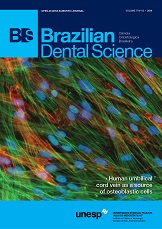Influence of abutment material on peri-implant clinical parameters: a prospective study
DOI:
https://doi.org/10.14295/bds.2014.v17i3.972Abstract
Objective: This study evaluated the peri-implant clinical parameters of zirconia versus metallic abutments for standardized custom-made implantsupported single-tooth restorations. Material and Methods: Sixteen subjects received 30 dental implants on esthetic region of upper jaws. Test group had 14 implant-supported single-tooth restorations with ceramic abutment and control group had 16 restorations with metallic abutment. Peri-implant clinical parameters were recorded after 110 ± 10 days in function at six sites by each implant, in each subject. The means of clinical measures: probing depth (PD) and clinical attachment level (CAL); mean of percentages of sites with visible plaque (VP), bleeding on probing (BOP) and suppuration (SU) were recorded to each subject. To verify differences between groups Mann Whitney U-test was selected PD and CAL and k-light test VP, BOP and SU. Results: One zirconia implant-supported single-tooth restoration fractured at insertion time. The mean of PD, CAL, and BOP of the samples sites were lower to test group than control (p < 0.05). There were no differences of mean levels of VP and S between test and control group (p > 0.05). Conclusion: Clinical parameters around implant-supported restorations were influenced by abutment type with better results to zirconia abutments, at least, after short time period evaluation.
Downloads
Downloads
Published
How to Cite
Issue
Section
License
Brazilian Dental Science uses the Creative Commons (CC-BY 4.0) license, thus preserving the integrity of articles in an open access environment. The journal allows the author to retain publishing rights without restrictions.
=================




























